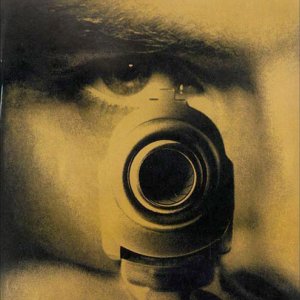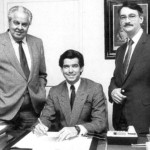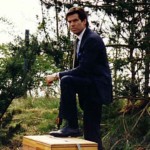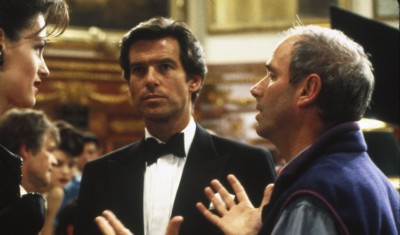
In many ways the year 1995 was a watershed moment for the James Bond franchise. A number of critics had written off the series and questioned the need for a post-Cold War spy hero.
But ‘Cubby’ Broccoli was determined to overturn such pessimism and prove that the 007 films remained as relevant and entertaining as ever. He was right. The 17th Bond movie, Goldeneye, was hugely successful and arguably reinvented the series.
During the course of 2020 the JBIFC have been celebrating the 25th Anniversary of Goldeneye, Pierce Brosnan’s debut film as James Bond, and Martin Campbell’s first 007 movie as director.
In 2019 both the main star and director contributed to an article for the ‘How We Made…’ series of articles published in the UK’s Guardian newspaper, and we thought it is worth revisiting their thoughts and memories as set out in the article.
Brosnan and Bond
Pierce Brosnan started his contribution to the article by recalling his encounters with 007 before he won the role of Bond in Goldeneye. He said that the first film he had seen when he came to London as a boy was Goldfinger, which he described as a ‘bedazzling moment’; he said he got a toy car with an ejector seat, ‘but didn’t have any aspirations to be James Bond. The character who really captured my imagination was Oddjob, Goldfinger’s bowler-hatted henchman’.

Brosnan said he had originally been offered the role of 007 for The Living Daylights: ‘I’d done all the photos with the iconic gun pose and my late wife and I were about to toast our new life with a bottle of Cristal when my agent called and said: “It’s fallen through”. I couldn’t get out of Remington Steele’. (The role of 007 went to Timothy Dalton instead).
Referring to the six-year gap in Bond production after 1989 (because of a rights dispute), Brosnan said he had heard rumblings that the part was available, but he ignored them ‘because I didn’t want to put myself back in that emotional vortex’. He eventually met the producers Cubby and Barbara Broccoli and, a week later, they called and told him he was now James Bond.
Bond, James Bond…
Brosnan recalled: ‘The sceptics were out in full: the world felt there was no need for another Bond. So the challenge was enormous. I didn’t want to get caught between what Sean and Roger had done. Yet, at the end of the day, my take was a little bit of what both had brought to the role. I leant towards Sean’s style, but couldn’t deny Roger because Goldeneye was made in the tongue-in-cheek manner people had become used to’.

Brosnan added: ‘It was a demanding role, physically and emotionally. I did a lot of wirework and fight sequences. They created a padded cell for the fight in the bathhouse with Xenia Onatopp, so we could go at it hard. The most arduous fight was the one with Sean Bean, on the ladder over the giant radio telescope at the end. He and I spent six weeks constructing the sequence, working on it during our lunch breaks and at the end of the day with a stunt coordinator. But carrying myself as Bond was as much a mental as a physical thing. You have to hold the stage. You go in to win, full tilt to the finishing line’.
Campbell’s Memories
The director of Goldeneye, New Zealander Martin Campbell, also contributed to the ‘How We Made’ article. He reflected: ‘It’s exciting breaking in a new Bond. I did Daniel Craig’s first one, too’.
On the production of Goldeneye, Campbell recalled: ‘It was budgeted at $55m, ludicrously little by today’s standards. I think United Artists had doubts about how the audience would respond after the big gap. The press had been asking if Bond was relevant. We decided to address this, so we introduced Judi Dench as M…’.
Campbell also remembered: ‘We were very tight on budget by the time we got to the tank chase through St Petersburg, so we built replica streets in the studios at Leavesden. We had three or four Soviet battle tanks, T-55s, the proverbial, unstoppable force. You just let the bloody ting go and it knocks down anything. one crashed through a wall, ran over a Panavision camera and flattened it’.
Interestingly, Campbell rounded off his contribution by explaining: ‘I turned down Pierce’s subsequent films. There’s always a madman taking over the world and a control room to be blown up. The producers felt the last of the Brosnan Bond films, Die Another Day, had got too fantastical, with the invisible car and the ice palace. They decided there had to be a complete rethink. That’s how Casino Royale came about’.
Did You Know?
Martin Campbell followed a very disciplined routine when working on Goldeneye. Staying at a rented house in Swiss Cottage in London, he would be driven to Leavesden for a 5.30am start, spend the next two hours planning the day, take breakfast on the set at 7.30am, and then start shooting at 8.00am sharp. This would continue until 7.00pm every evening, with only a one-hour lunch-break. He maintained this strict routine for six days a week for 20 weeks, and often also worked on general admin on Sundays, too! Members of the cast wondered where Campbell got all his energy from.

Famke Janssen, Pierce Brosnan and Martin Campbell on set.
